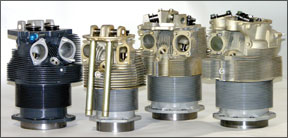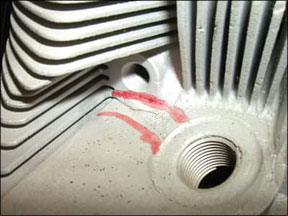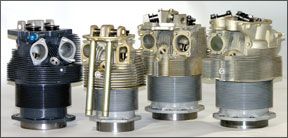One perennial rite of passage for aircraft owners is what to do about cylinders at overhaul. Whether were talking about top-end work on a mid-time engine, or one we’ll past its published TBO, which cylinders to install can be a major decision. And its not getting any easier. In fact, there’s an element of crisis in the cylinder business. Superior Air Parts was once a major supplier, but is gone from the scene. Continental and ECI have both suffered significant quality issues affecting thousands of cylinders. A recent AD impacts owners of existing Superior cylinders, rendering what was once the cream of the cylinder crop as one-run wonders. One way out of that morass, of course, is to buy a new or factory-rebuilt engine: you’ll get factory jugs. But given Continentals troubles, thats no panacea, either. For those facing top-end work or an overhaul, the choices are more complex. And theyve gotten even harder in recent years given the aforementioned ADs and bulletins. Lycoming owners have it a bit easier: There are no recent ADs against factory cylinders or those supplied by Superior. But anyone with an aftermarket cylinder or flying a Continental engine is probably feeling a little paranoid about all this. After the last three years of ADs, whats going on? Cant anyone make a cylinder anymore? What do engine rebuilders recommend? And what should an owner do when its time to replace one or all of an engines jugs?
Whats The Problem?
The recent spate of ADs against just about every cylinder except Lycoming factory jugs has its roots in the economics of manufacturing. Simply put, its rare for an aircraft piston engine cylinder to be manufactured entirely by the company marketing it. Instead, the work often is farmed out to foundries who cast the cylinder head and barrel and perhaps to another company for heat-treating and machining. Eventually, theyre assembled and packaged in a box labeled Continental, ECI or Lycoming.
Regardless of who does the casting and other work, occasionally a tool will be mis-rigged or a critical process overlooked, resulting in parts not meeting specification. State-of-the-art statistical process control and/or quality inspections are supposed to catch this.
But breakdowns in the QC process don’t affect just cylinders-ask anyone familiar with recalls and ADs on crankshafts from both Lycoming and Continental over the past decade. The bottom line? Stuff happens. And when that stuff involves the potential for cracking, barrel separation and other failure modes, the manufacturers and the FAA get involved.
Most recently, the FAA issued AD 2009-19-07, placing its stamp of approval on a Continental mandatory service bulletin first issued earlier this year. That MSB informed owners of a recall program, including reimbursement, for a bad batch of Continental cylinders prone to cracking.
Over the summer and after a lengthy comment period resulting in 36 public comments-a large number for something as mundane as a cylinder AD-the FAA finalized AD 2009-16-03 against Superior cylinders installed on Continental engines

for similar problems, plus barrel separation.
Meanwhile, a pair of ADs issued against ECI cylinders installed on Lycoming engines and dating to 2008 and 2006 also focused on head/barrel separation. A fifth AD, 2007-04-19R1, targeted a batch of Superior cylinders installed on either Lycoming or Continental engines for fatigue and-stop us if youve heard this before-possible head/barrel separation. The table above summarizes five cylinder ADs issued since 2006, including their inspection or removal requirements.
If there’s any doubt these five ADs have an impact, consider this: They total almost $30 million in additional costs to owners and operators in the last three and one-half years alone, according to the FAAs often-too-low economic impact estimates. That number doesnt include costs associated with ADs 2007-04-19R1 or 2009-19-07, for which Superior and Continental, respectively, provide labor and shipping reimbursement, nor does it include downtime or other costs, like the fuel necessary to get the airplane to an appropriate shop.
What Do The Shops Say?
Generally, when we asked engine gurus about all this and which cylinders they might recommend installing and why, the answers focused on the engines utilization, how its flown and by whom, and where the airplane is based-a dry environment or a wet one. One thing they all noted is that no one can provide a 100-percent guarantee a set of jugs wont have problems. As one wag put it, if you don’t want to risk cracked cylinders, “get a jet.”

It shouldnt come as a surprise to learn that cylinder longevity depends a great deal on the environment in which the engine is flown and stored, plus the way its operated. “The main thing that needs to happen is operator education,” Penn Yan Aeros Alex Courtney told us. “It used to be pilots knew how their engines worked. Nowadays, we find the pilot didnt operate it properly.” According to Courtney, heat is the enemy, and leaning procedures compound heat-related problems: “Heat is one of the top two things,” he told us. “Cylinder life is directly related to heat and oil cleanliness,” he added. The moral? Keep the jugs cool-whether with fuel (rich of peak EGT) or air (lean of peak)-to help prevent both cracking and exhaust valve guide wear. And change the oil often.
Another variable is the engine and whether it has OEM cylinders. For example: “We just havent had a problem with Lycoming factory cylinders,” Zephyr Aircraft Engines Charlie Melot told us. “Especially the parallel-valve cylinders-theyve been flawless.” Courtney agreed, telling us that Lycoming OEM cylinders “are probably the best on the market right now. Its really a good cylinder,” with few in-service problems cropping up, including cracks or valve issues. Obviously, the same cant be said for Continental factory jugs, although some engine rebuilders think theyve broken the code (see the sidebar at left). Others, however, either arent convinced, don’t want to do that kind of work on new cylinders or simply prefer installing something else. “Superior made a pretty good cylinder,” Melot told us, but the companys problems mean its no longer an option. Instead, hed install ECI cylinders processed with the companys nickel-carbide bore coating. Standard, uncoated cylinders also are available from ECI.
And thats probably the best solution for Continental engines, especially if they don’t fly that much. Said Courtney, “Id recommend ECI because Continentals barrels usually don’t go the distance,” highlighting a problem weve heard elsewhere. Perhaps related is the loss of choke-a slight tapering of the cylinder bore toward the top of the cylinder to ensure piston rings fit correctly when the jug heats up and expands. Historically, another issue with Continental cylinders is exhaust valve guides, which can wear prematurely and prevent the valve from fully seating.
Zephyr Aircraft Engines Melot agrees with the idea of using ECIs coated cylinders on a Continental engine, also agreeing theyre best for a low-utilization engine. “The coating goes a long way toward preventing corrosion. They cant rust,” he said. “Its been so long since we had a problem with an ECI cylinder, whether steel (uncoated) or coated. Its an easy choice, especially when compared to an OEM jug,” he added. Melot also had the best response when we asked about the recent spate of ADs. He cautioned: “It isn’t about who had the last AD; its about who has the next one.” Put another way, cylinder choices should focus on your engine, how you operate it and the environment in which you fly and store the aircraft.
So, Which Cylinder?
In our May 2008 issue, we said, “Based on…our survey of owners and shops, factory-new or ECI are good bets for Lycoming engines. ECI would be our pick for Continentals.” That survey focused on owner experience with different engines and cylinders. Since then, three new ADs-one each on cylinders from Continental, ECI and Superior-have gone into effect, but nothing anyones added to this conversation really changes our 2008 conclusion. Further, making a cylinder-purchase decision solely on the basis of existing ADs doesnt make much sense to us; other factors should be considered, also.
If youre flying Lycoming products and need cylinders, the decision should be a no-brainer: Buy factory jugs. Lycoming seems to have figured out how to manufacture new cylinders without incurring an ADs wrath. (At least until the next cylinder AD comes out, anyway.) One shops guru told us of the time he asked Lycoming-only half-jokingly-when they were going to start making jugs for Continental engines.
The only caveat involves low-utilization airplanes: If its likely the engine wont get flown frequently, ECI cylinders with the companys proprietary anti-corrosion nickel and silicon carbide composite coating might be the way to go. But Lycoming engines with ECI cylinders arent immune to an AD.
For a Continental engine, its more challenging. The company has a long history of problems with its cylinders, even if its Top Care supplemental warranty program has minimized owners financial risk. Also, Continental stepped up to the plate and created a reimbursement program for owners caught by AD 2009-19-07 and its accompanying service bulletin.
Again, though, how and how much you fly figures prominently. High-utilization operators generally report good service from their Continental factory cylinders, often running them to or beyond TBO without drama. If you don’t plan to fly your Continental engine much, installing ECIs coated jugs is probably the way to go, to help minimize any corrosion-related problems.
Recent problems don’t seem to be in the design; its the manufacturing process. So, its reasonable to conclude a set of factory jugs from a properly manufactured batch is about as solid as they can be. But the potential for a costly AD is always present. The worrisome and thus far intractable problem is that no one has figured out how to predict any of this yet. Best bet? Go with cylinders from a source with the fewest complaints.


